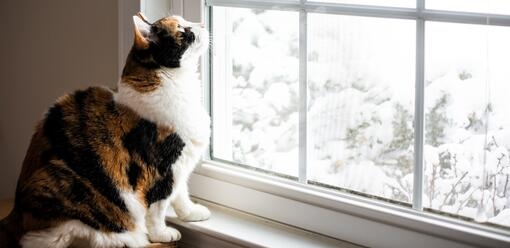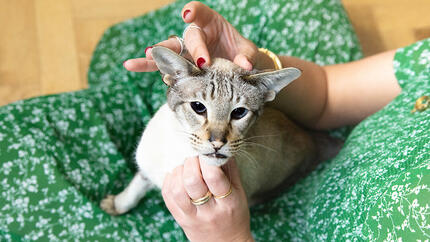
It may be difficult to believe that cats get cold despite them being extremely adaptable creatures. If your cat gets too cold, they could be at risk of health conditions such as hypothermia and frostbite.
When the colder weather starts to set in, it is important to know when the temperature is too low for your cat and when they should be kept nice and warm inside. So, do cats feel the cold, and if so, when is it too cold for them?
Do cats get cold?
Unless cats are a short-haired or hairless cat breed, they tend to stay quite warm due to their thick coats. However, despite this, cats do get cold. The general rule of thumb is that, if you are feeling cold, then the chances are your cat is too.
Do cats feel cold?
Cats’ coats do a great job of insulating them against the cold, which is great news if they tend to spend the majority of their time outside. In saying that, outdoor cats can still suffer from hypothermia or frostbite if they are left outside too long. However, most cats have a pretty good sense of when it is getting too cold, and will choose to stay inside.
Do kittens feel cold?
Those lovely bundles of joy are so small and precious – they must feel the cold? In the early days, their mum will keep them warm by letting them snuggle up to her. However, from around 3 weeks, kittens become a bit more independent and are better able to regulate their body temperature on their own, so by the time they get to the weaning stage, they won’t need additional heat support from mum.
However, if you are hand rearing kittens, then alternative heat sources may be necessary especially for the new born stage. Remember to be careful if using heat pads or hot water bottles as these could scald them. So, to keep kittens warm, it is best to use plenty of clean, soft blankets and if using hot water bottles, these should have a cover on them.
When is it too cold outside for cats?
As a general rule of thumb, any temperature under 7 degrees Celsius is considered quite cold for cats, and if the temperature dips below freezing, then you should make a conscious effort to keep your cat indoors. Allowing your cat to remain outside for long periods of time in such temperatures could be detrimental to their health.
How will I know if my cat has mild hypothermia?
The signs to look out for if you suspect your cat has hypothermia include:
- Weakness
- Shivering
- Lack of mental alertness
- Body temperature below 37 degrees Celsius
- Cold ears and paws
How will I know if my cat has severe hypothermia?
If you suspect your cat has severe hypothermia you should alert your vet immediately, as this could have long lasting health effects for your cat and could be fatal. The signs to look out for include:
- Severe lethargy
- Slow heart rate
- A difficulty in breathing or slow breathing rate
- A very low body temperature
- Loss of consciousness
How will I know if my cat has frostbite?
Frostbite in cats is a serious condition. If you think your cat is affected by frostbite, or notice any affected areas, then you should get in contact with your vet immediately. Signs to look out for are:
- Discolouration of the affected area of skin – this will often be pale, grey or have a bluish tint.
- Pain when touching the affected area
- Blisters or skin ulcers
- Blackened or dead skin areas
How do I keep my cat warm when it’s cold outside?
With many cat owners allowing their cats to venture into the outside world as and when they please, it is important to understand how to protect them and keep them healthy, especially when temperatures drop and being outdoors might pose a threat to your cat’s wellbeing.
Watch their weight
It is easy to misjudge your cat’s weight, especially when they are covered up by that thick warm winter coat. Make sure you feel your cat and check for any bony hips or shoulders, which may signal that your cat is unwell and is losing weight.
It is also important to keep an eye on your cat’s weight when they are spending more time indoors, as being less active makes them at increased risk of gaining weight. Our cat body conditioning tool is a great way to stay on top of your cat’s weight.
Make sure their bed is nice and cosy
Your cat is bound to have their favourite sleep spot, whether that’s in a cat bed, on your bed or tucked up on the windowsill. Making it as warm and welcoming as possible when they are housebound by chilly weather is the route to a happy cat! Make sure to wash the bedding regularly.
Watch for stiffness
Keeping a cat indoors can be strange for both you and them, especially if they are an adventurous feline. Making sure to keep them as stimulated indoors as they would be outside is crucial, so keep them moving with plenty of fun cat games. The cold can increase the risk of joint stiffness and pain, so if your cat is finding it hard to reach some of their favourite places, book an appointment for a vet check without delay. You can make it a little easier for cats with mobility problems by making sure their bed and litter tray are both easily accessible.
How will I know if my cat is cold?
Cats are very good at hiding their discomfort, so knowing whether your cat is cold or not will be tricky. There are a few things you can check to give you clues as to whether your cat is cold or not.
Check their ears, paws and tail
If your cat is cold, their extremities may start to feel cold to the touch. So have a feel of your cat’s ears, paws and tail and if these body parts feel cold, then chances are your cat is cold.
Choosing to sleep by the heat
If your cat is leaving their usual snoozing area to lie by the radiator, or waking up to move closer to a heat source, then this is another telling sign that your cat is feeling the cold.
Curling into a ball
For many cats this is their go-to sleeping position, but this position can sometimes be a sign that they are feeling the cold. A cat that is feeling the cold will also tuck their paws and tail underneath them to keep extra warm.
Always make sure that your cat is well fed, and watered. If you do let your cat out, or they manage to get out in the cold, then it is always a good idea to have sheltered areas raised off the ground, where they are protected from the worst of the cold and damp.
Looking after your cat during the colder months doesn’t have to be a total life change for you or your feline friend, but ensuring you are equipped and ready when the time comes will make things much easier. Now, that is our guide on “do cats feel the cold”, and hopefully we have given you some useful tips! If you want to know more about ways to keep your cat safe, why not read about how to cat proof your garden, next.









